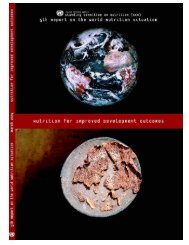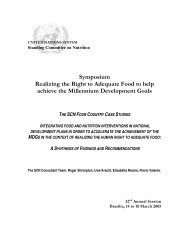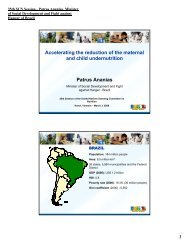52FEATURESwww.unsystem.org/scntime, in cross-sectional surveys, it might be prudent to assess the iodine nutrition status of school-age childrenand to sample pregnant women from prenatal clinics.In some national cross-sectional surveys, the urinary iodine laboratory results have been considered invalid.Therefore laboratories must use recommended procedures for measuring iodine in urine (WHO 2001), haveinternal quality control, and also participate in an external quality control program. One such external qualitycontrol program is the Centers for Disease Control and Prevention’s (CDC’s) Ensuring Quality of UrinaryIodine Procedures Program (EQUIP) (Caldwell et al 2005b).In Georgia’s 2005 national IDD survey, urine samples were collected from 30 randomly selected studentsaged 6-12 years from each of 30 representative secondary schools. Iodine content was measured at CentreHospitalier Universitaire Saint-Pierre in Brussels, Belgium. This laboratory is part of the International ResourceLaboratories for Iodine (IRLI) Network. The median urinary iodine was 321 μg/L, and only 4.4% of thesamples were below 100 μg/L.In Switzerland, a survey conducted in 1999 led to concern over low median urinary iodine levels in schoolchildren and pregnant women (Zimmerman et al 2005). Because of these findings, the level of iodine in saltwas increased from 15 ppm to 20 ppm. A survey in 2004 found improvements in the urinary iodine levels inboth groups.Iodized salt used in food productionCompared to the experience in assessing the proportion of households using iodized salt, there is relativelylittle experience in addressing the use of iodized salt in the food industry. Some countries require only tablesalt to be iodized, whereas others require both table salt and salt used by the food industry to be iodized. Indeveloped countries, there is concern that only a small proportion of salt in the diet is derived from table saltand that most salt comes from processed foods, which in most countries is not iodized. The use and monitoringof iodized salt in the food industry is an area in need of further investigation.Indicators of sustained elimination of IDDA number of countries have been successful in eliminating iodine deficiency but have subsequently lapsedinto significant iodine deficiency problems (for example, see Stewart et al 1996). WHO has provided a list ofprogrammatic indicators important to ensuring the sustained elimination of IDD (Table 4). The Network forSustained Elimination of Iodine Deficiency, when requested, can provide an external assessment of acountry’s progress towards achieving <strong>USI</strong>.In Georgia, the rapid virtual elimination of IDD is likely due to the effective implementation of legislationmandating the iodization of salt. Georgia has a strong regulatory structure, and the government has beenwilling and able to enforce legislation on the iodization of salt. For example, the chair of the Georgian NationalFortification Alliance is also an influential member of parliament who regulates enforcement mechanisms. Tosustain elimination of IDD, Georgia has introduced an ongoing monitoring and evaluation system to assesssalt quality at all levels of the iodized salt supply. Ongoing political commitment and cooperation from saltimporters in ensuring import of iodized salt are important for sustained elimination of IDD.ConclusionsThe proven strategy for eliminating iodine deficiency in the vast majority of populations is through theiodization of all salt for human and animal consumption. Key to this strategy is ensuring that all locally producedand imported salt meets the national standards for iodine levels. Periodic surveys should assess theproportion of households using iodized salt and the iodine nutrition status of the population. Iodine deficiencycan be eliminated, but it requires continual oversight to ensure sustained success.ReferencesAndersson M, Takkouche B, Egli I, Allen HE and de Benoist B (2005) Current global iodine status and progress over thelast decade towards the elimination of iodine deficiency. Bull World Health Organ 83:518-25.SCN NEWS # 35 back to contents
www.unsystem.org/scn FEATURES 53Caldwell KL, Jones R and Hollowell JG (2005a). Urinary iodine concentration: United States National Health andNutrition Examination Survey 2001-2002. Thyroid 15(7), 692-9.Caldwell KL, Makhmudov A, Jones R and Hollowell JG (2005b) EQUIP: a worldwide program to ensure the quality ofurinary iodine procedures. Accred Qual Assur 10:356-61.Copeland DL, Sullivan KM, Houston R, May W, Mendoza I, Salamatullah Q, Solomons N, Nordenberg D and MaberlyGF (2002) Comparison of neonatal thyroid-stimulating hormone levels and indicators of iodine deficiency in schoolchildren. Public Health Nutrition 5(1), 81-7.Delange FM (2002) Iodine deficiency in Europe anno 2002. Thyroid International 5.Gorstein J, Sullivan KM and Houston R (2001) Goiter assessment: help or hindrance in tracking progress in iodinedeficiency disorder control program? Thyroid 11(12):1201-2.Gorstein J, Sullivan KM, Parvanta I and Begin F (2007) Indicators and Methods for Cross-Sectional Surveys of Vitaminand Mineral Status of Populations. Micronutrient Initiative and the Centers for Disease Control and Prevention. (online)Houston R, Lotfi M, Nathan R and Pandav C (1999) Assessing Country Progress in <strong>Universal</strong> <strong>Salt</strong> <strong>Iodization</strong> Programs:Iodized <strong>Salt</strong> Program Assessment Tool (ISPAT). ICCIDD, MI, OMNI, PAMM, UNICEF, USAID, WHO, MicronutrientInitiative, Ottawa.ICCIDD (2007) Iodine requirements in pregnancy and infancy: A WHO Technical Consultation has produced newguidelines on iodine requirements and monitoring in these vulnerable age groups. IDD Newsletter 23(1):1-2.Nathan R (1999) Regulation of Fortified Foods to Address Micronutrient Malnutrition: Legislation, Regulations, andEnforcement. Micronutrient Initiative: Ottawa.Stewart C, Solomons N, Mendoza I, May S and Maberly G (1996) <strong>Salt</strong> iodine variation within an extended Guatemalancommunity: The failure of intuitive assumptions. Food Nutr Bull 17.Sullivan KM, Houston R, Gorstein J and Cervinkas J (1995) Monitoring <strong>Universal</strong> <strong>Salt</strong> <strong>Iodization</strong> Programmes. UNICEF,PAMM, MI, ICCIDD and WHO. (online)Sullivan KM, Shahriari A, Houston R, May W, Mendoza I, Salamatullah Q, Solomons NW, Schultink W, Gross R, Xu Fand Maberly GF (2005) Comparison of different indicators of iodine deficiency in school children. Int J Endocrinol Metab1:1-19.UNICEF (2004a) Achieving <strong>Universal</strong> <strong>Salt</strong> <strong>Iodization</strong> in Georgia: 2004-2005 Plan of Action. Unpublished conferencereport: “Strengthening Partnership for Elimination of Iodine Deficiency in Georgia,” June 25-28 2004, Tbilisi, Georgia.UNICEF (2004b) Sustained Elimination of IDD through <strong>Universal</strong> <strong>Salt</strong> <strong>Iodization</strong> in Georgia 2001-2005. Annual progressreport. Tbilisi, Georgia: Government of Georgia/UNICEF.UNICEF (2006) The State of the World’s Children 2007. UNICEF:New York. (online)WHO/UNICEF (2007) Iodine deficiency in Europe: A continuing public health problem. WHO:Geneva. (online)WHO/UNICEF/ICCIDD (1996) Recommended Iodine Levels in <strong>Salt</strong> and Guidelines for Monitoring Adequacy andEffectiveness. WHO/NUT/96.13, WHO:Geneva. (online)WHO/UNICEF/ICCIDD (1998) Joint WHO/UNICEF/ICCIDD consultation. Review of findings from 7-country study inAfrica on levels of salt iodization in relation to iodine deficiency disorders, including iodine-induced hyperthyroidism.WHO/Afro/NUT/97.2 - WHO/NUT/97.5, WHO:Geneva.WHO/UNICEF/ICCIDD (1999) Progress towards the elimination of iodine deficiency disorders (IDD). WHO/NHD/99.4,WHO:Geneva.WHO/UNICEF/ICCIDD (2001) Assessment of Iodine Deficiency Disorders and Monitoring their Elimination: A Guide forProgramme Managers (2 nd Ed). WHO/NHD/01.1, WHO:Geneva. (online)Zhao J, Xu F, Zhang Q, Shang L, Xu A, Ghao Y, Chen Z, Sullivan KM and Maberly GF (1999) Randomized clinical trialcomparing different iodine interventions in school children. Public Health Nutr 2:173-8.Zimmermann MB, Hess SY, Adou P, Toresanni T, Wegmüller R and Hurrell RF (2003) Thyroid size and goiterprevalence after introduction of iodized salt: a 5-y prospective study in schoolchildren in Côte d'Ivoire. Am J Clin Nutr 77(3):663-7.Zimmermann MB, Aeberli I, Torresani T and Bürgi H (2005) Increasing the iodine concentration in the Swiss iodized saltprogram markedly improved iodine status in pregnant women and children: a 5-y prospective national study. Am J ClinNutrition 82:388-92.Zimmermann MB, de Benoist B, Corigliano S, Jooste PL, Molinari L, Moosa K, Pretell EA, Al-Dallal ZS, Wei Y, Zu-Pei Cand Torresani T (2006) Assessment of iodine status using dried blood spot thyroglobulin: development of referencematerial and establishment of an international reference range in iodine-sufficient children. J Clin Endocrinol Metab. 91(12):4881-7.Contact: kms2@cdc.govback to contents SCN NEWS # 35







